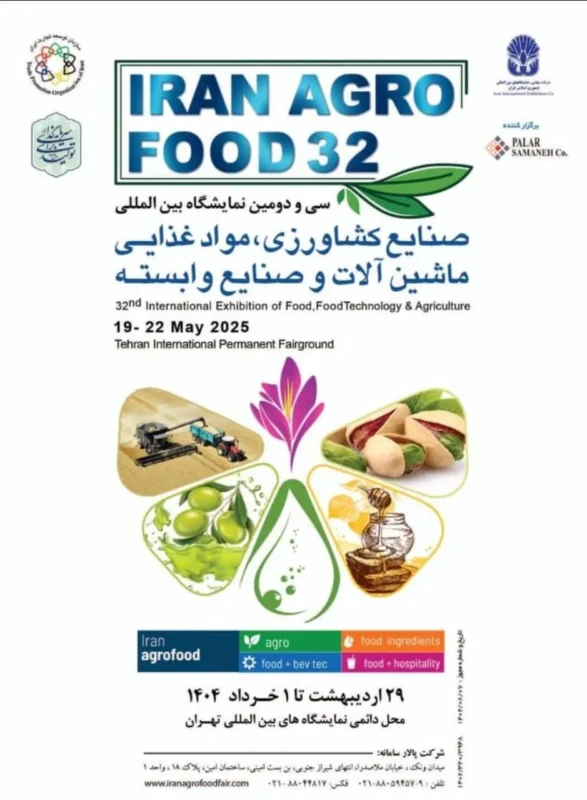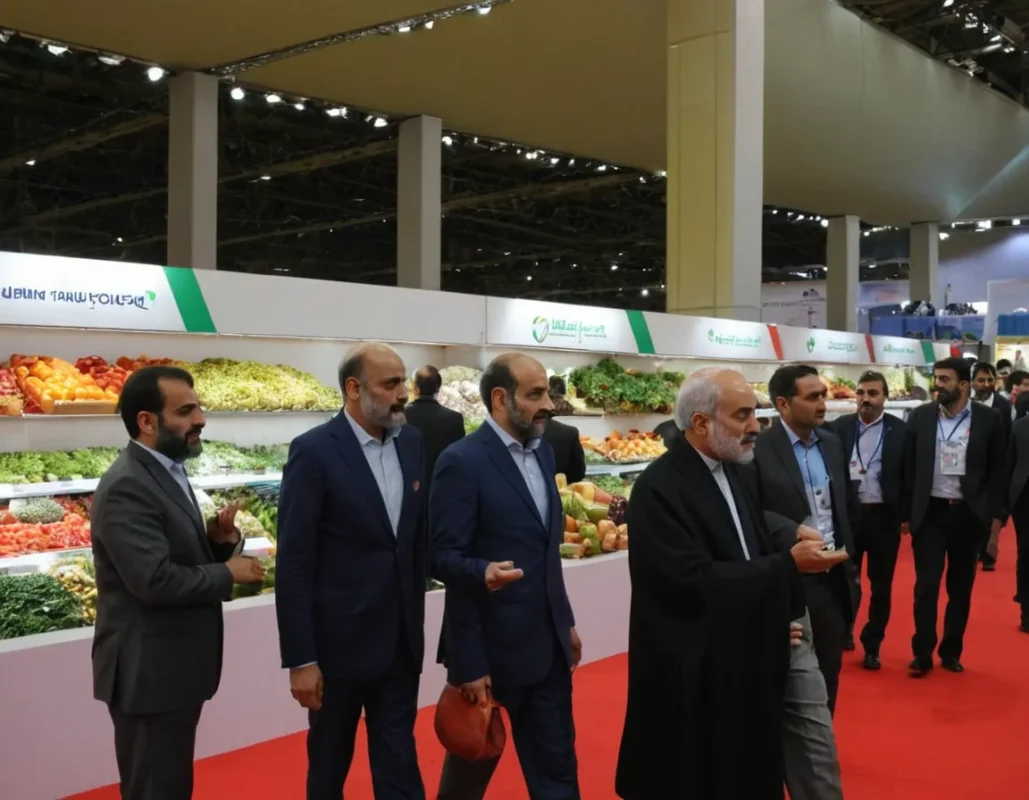فهرست مطالب
- 1 Introduction: An exhibition that will transform Iran’s agricultural economy
- 2 Event details: from official presence to international diversity
- 3 Key sections of the exhibition: From innovation to commercialization
- 4 The role of the exhibition in the national economy: numbers and facts
- 5 Challenges and Solutions: A Critical Look
- 6 Innovation in Booth Design: The Art of Attracting Attention
- 7 Final words: The future of Iranian agrofood on a global scale
Tehran, May 19, 2025
Introduction: An exhibition that will transform Iran’s agricultural economy
Exhibition News – The 32nd International Exhibition of Agricultural, Food, Machinery and Related Industries (Iran Agrofood 2025) opened at the Permanent Exhibition Center of Tehran International Exhibitions with the slogan “From Farm to Table; Innovation for a Sustainable Future.” The event, known as the largest gathering of food and agricultural industries in the Middle East , not only plays a vital role in introducing the latest technologies, but also acts as a bridge between domestic producers and global markets. As Iran seeks to increase non-oil exports and strengthen food security, holding such an exhibition provides an exceptional opportunity to attract investment , transfer technical knowledge, and establish business networks.
Event details: from official presence to international diversity
Official opening with the presence of industry elites:
The opening ceremony of the exhibition was attended by Sedif Beikzadeh , CEO of Iran International Exhibitions Joint Stock Company, Akbar Fathi , Deputy Minister of Planning of the Ministry of Agricultural Jihad, and Ebrahim Sheikh , Deputy Minister of Industrial Affairs of the Ministry of Industry. Beikzadeh emphasized in his speech:
“Iran Agrofood is not just an exhibition; it is also a symbol of the convergence of the resistance economy and the international economy. The presence of leading companies from 12 countries around the world shows that Iran, despite the challenges, has become an attractive destination for technological cooperation.”
Impressive statistics:
-
750 domestic companies from different provinces of Iran, including Khorasan Razavi (as an agricultural hub), Isfahan (industrial machinery center), and Gilan (a leader in the production of organic products ).
-
138 foreign companies from countries such as Germany, Italy, Russia, Turkey, India, and Brazil.
-
50,000 square meters of exhibition space including 10 specialized halls, each focused on a specific area such as smart agriculture, sustainable packaging, or transformation technologies.
Time and place:
This event will host industry activists, investors, and interested parties from May 19 to June 14, 2021, daily from 8:00 AM to 3:00 PM.
Key sections of the exhibition: From innovation to commercialization
1. Technology-focused booths: German and Italian companies have attracted a lot of attention
by presenting agricultural machinery equipped with artificial intelligence . For example, the German Kleisner booth displays harvesting machines for crops such as pistachios and saffron that can identify healthy crops with 98% accuracy.
2. Food and export markets:
Iranian companies such as “Zarmakaron” and “Kale” are aiming to attract European and Asian markets by offering new products such as pasta enriched with insect protein (as a sustainable alternative) and lactose-free dairy products .
3. Sustainable packaging:
With increasing global pressure to reduce plastic, companies such as Nopack from Iran and Tetra Pak from Sweden have introduced biodegradable packaging samples made from algae and starch.
4. Related Industries and Logistics:
Dedicated booths pay special attention to cold chain management systems , as Iran seeks to increase exports of perishable products such as fruit and meat to neighboring countries.
The role of the exhibition in the national economy: numbers and facts
1. Attracting foreign capital:
According to the announcement of the Ministry of Agricultural Jihad, it is expected that initial agreements for an investment of 300 million euros in the field of smart agriculture will be signed between Iranian and European companies.
2. Job creation: The boom in processing and packaging industries could create 50,000 direct jobs
by 2027 , especially in rural areas that face the problem of youth migration.
3. Reducing imports:
Introducing domestically manufactured machinery (such as fruit drying machines by Sanam Sanat Company ) could reduce Iran’s dependence on Turkish and Chinese imports by up to 40%.
4. Export Development:
In 1403, Iran’s agricultural exports reached $6.2 billion. This figure is expected to grow by 20% next year with the presence of foreign buyers at this exhibition .
Challenges and Solutions: A Critical Look
1. Sanctions and restrictions:
Although European companies such as Austria and Germany have a strong presence, the absence of American companies and some Arab countries is noticeable due to sanctions. However, Russia and China have made attractive proposals in the field of vertical farming as alternative partners.
2. Exhibition infrastructure:
Some foreign participants have complained about the lack of storage space at the exhibition site. Officials have promised to address this problem by expanding new halls next year.
3. International advertising:
According to Marco Riccardi , director of the Italian pavilion, Iran should make the Iran Agrofood brand more global by participating in exhibitions such as Anuga in Germany.
Innovation in Booth Design: The Art of Attracting Attention
Digital Experiences at Booths: Companies are using virtual
reality (VR) tools to showcase the manufacturing process. For example, visitors can take a virtual journey from a pistachio farm in Rafsanjan to a packaging line in Tehran using VR headsets .
Sustainable design: Brazilian company JBS’s
booth , using recycled wood and solar lighting, exemplifies a commitment to the environment. This approach not only reduces costs but also indirectly communicates the brand’s message.
Direct consumer engagement:
Many booths have set up tasting stations. Visitors can try new plant-based cheeses or probiotic drinks and provide immediate feedback.
Final words: The future of Iranian agrofood on a global scale
The 32nd Iran Agrofood is not only a window on the world’s latest technologies, but also a test of domestic capabilities in the field of international competition. According to the announced plans, this exhibition is expected to become one of the top 10 agricultural and food exhibitions in Asia in the coming years . Achieving this goal requires comprehensive cooperation between the government, the private sector and international institutions. Ultimately, Iran Agrofood 2025 proved that even in complex geopolitical conditions, economic diplomacy can be the key to sustainable development.
Specialized dictionary:
-
Smart agriculture: Using technologies such as IoT and big data to optimize production.
-
Sustainable packaging: Eco-friendly materials that are biodegradable or recyclable.
-
Resistance Economy: An economic model that focuses on reducing dependence on foreign resources.
More information:
Official exhibition website: 32nd International Exhibition of Food, Food Technology & Agriculture
This report was prepared by the Booth Building System Analysis Team. Reprinting is permitted provided the source is cited.

